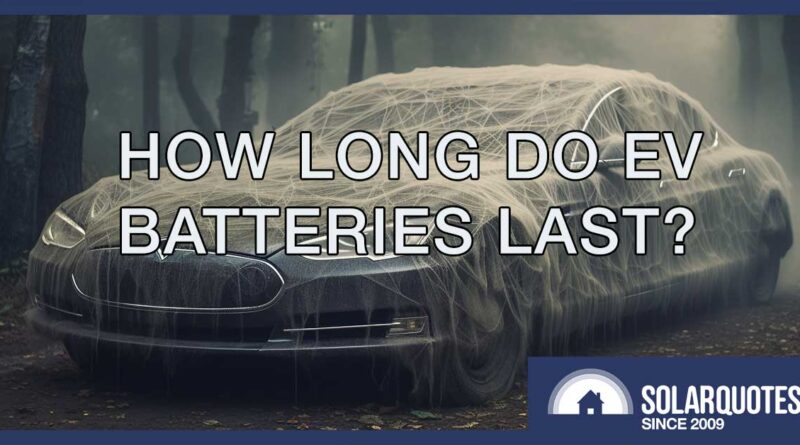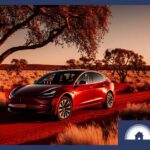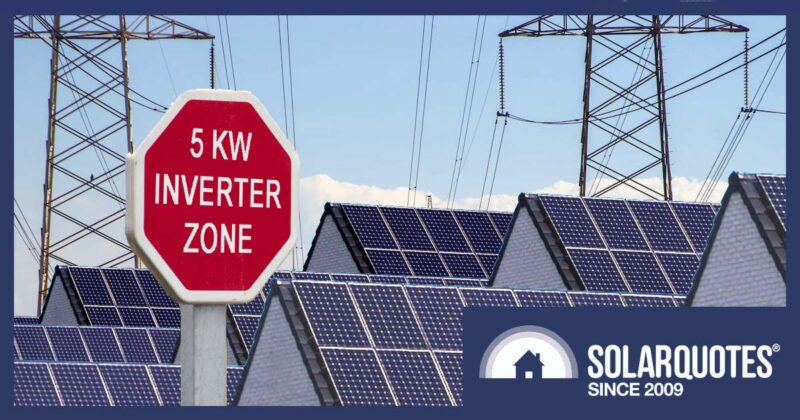US Study Shows EV Batteries Should Last An EV’s Lifetime
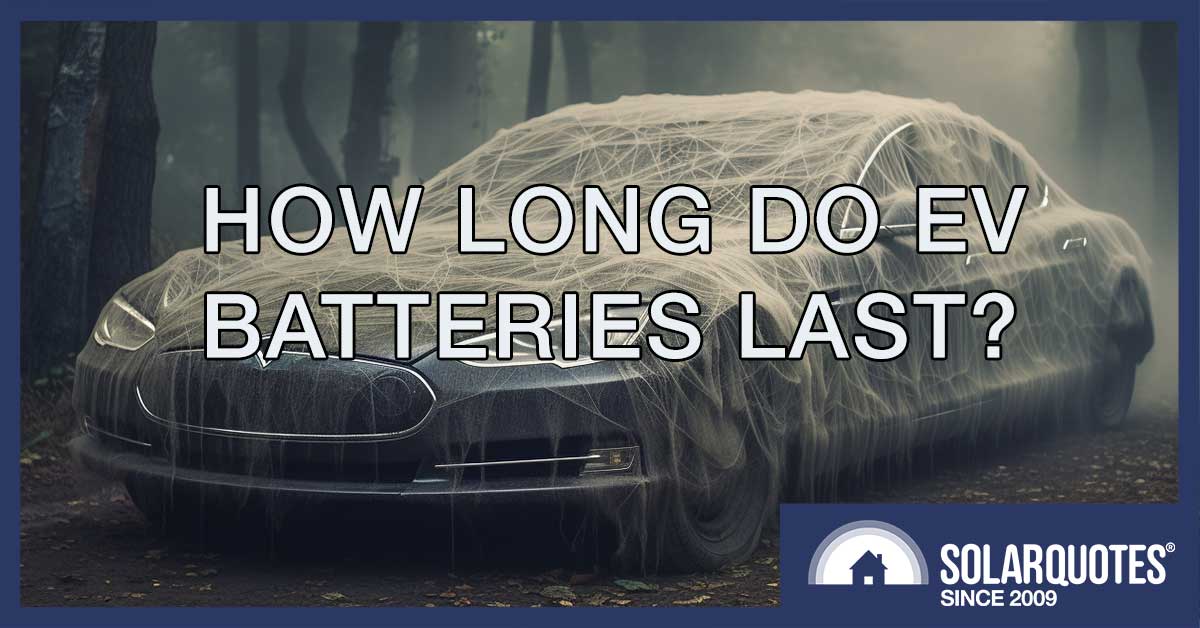
Good news! As your EV gets old, its battery should be fine.
How long do electric vehicle batteries last? According to a study by Recurrent — a US company devoted to helping people buy and sell used EVs — it’s a long time.
Their findings were:
- Not many Electric Vehicles have had batteries replaced so far.
- The decline in range of the EVs look at was modest, even when driving over 160,000km.
- The greatest decline in range normally occurs early in an EV’s life.
The study supports claims by manufacturers that their EVs and their battery packs will last 15-20 years. I’ve previously said the majority of EVs sold today will still have their original batteries in 15 years, so I’m glad they’ve backed me up on this.
You can check out the Recurrent study here. It has some neat graphs and is easy to read, so it doesn’t need to be translated from tech-head.
In this article, I will put their findings into an Australian context, including the liberal use of kilometres instead of miles. I’ll also happily engage in what they seem too polite to do and directly compare the range loss for the EV in the study. I’m throwing the following EVs into the range combat arena:
- Nissan Leaf
- Tesla Model S
- Tesla Model 3
- BMW i3
- Hyundai Ioniq 5
- Ford Mustang Mach-E
The study also looked at the Chevy Volt, but I’m leaving that plug-in hybrid out. Firstly, because it’s not a pure EV and, secondly, only around 250 were sold in Australia as the Holden Volt. Because they’re no longer produced and they stopped putting the steering wheel on the right side a long time ago, we’re not likely to see any more here.
15-20 Years Battery Life?
The study says manufacturers claim their EVs should last 15 to 20 years. While it’s definitely a good thing they don’t give a figure less than that, as an Australian, I have to say that’s a bit piss-weak. Here cars are used for over 21 years on average before they’re scrapped.
Some people mistakingly think cars don’t last that long because they look at the average age of cars on the road which, according to the 2021 motor vehicle census, is 10.6 years. But this means their average age at the end of their life has to be twice that at 21.2 years. That’s basic maths. You’d have to be thick to not immediately realise that. I didn’t immediately realize that when I first saw the average age figures, but I have an excuse. I’m very thick.
But the situation is probably better than the manufacturer’s 15 to 20 year figure suggests. US cars are driven around 21,000km a year; in Australia, the average is only around 13,000km. So for us, it may be more like 24 to 32 years, although that’s very optimistic. While most wear and tear on EV batteries is caused by km driven, some is simply from the passage of time, and that will rack up the older batteries get. Heat can also contribute to deterioration and — with regard to temperature only — Australia isn’t the coolest of countries.
On the bright side, provided the battery holds out, a lot less can go wrong with an electric car than a conventional one. Electric motors are extremely simple and can operate for over 30,000 hours. That’s over 100 years of Oz average annual driving. There’s no exhaust, catalytic converter, oil pump, or mystery belts mechanics always claim need to be replaced. This gives EVs the potential to be very long-lived. So fingers crossed, Australia gets at least 21 years of use from the average EV and its original battery.
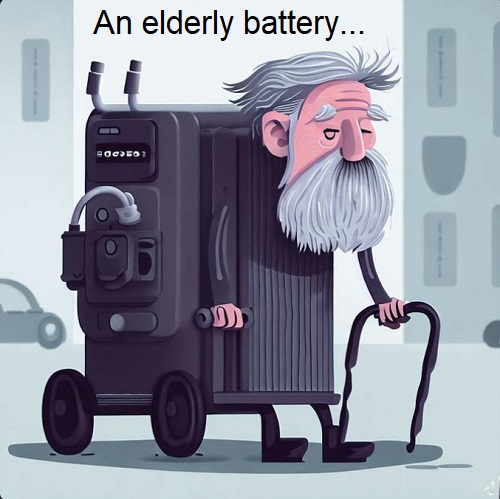
Now I’ve discovered the DALL-E AI image generator, I’m going to fill my articles with vast amounts of visual crap. If there aren’t at least 50 more stupid and awful images below, blame my editor!
Battery Replacements Low So Far
According to the study, only a small portion of EVs have required battery replacements so far. Of the around 15,000 EVs Recurrent keeps tabs on, only 1.5% have had their batteries ripped out and replaced. But there are a couple of reasons why that figure isn’t as good as it seems:
- EVs are still relatively new; in the US, their average age is under six years. But at least it’s longer than here.
- The figure doesn’t include battery replacements from major recalls.
If the average age of cars was 5 years and the 1.5% rate remains constant, then after 20 years, only around 6% of EVs will need battery replacements. Of course, it doesn’t actually work that way, and the older a vehicle gets, the more likely a replacement will be needed. If the 1.5% chance doubles every 5 years then the odds are 22% an EV will need its battery replaced at least once by the time it’s 20 years old.
But I don’t think the figure will turn out that high here. Firstly, the cars in the study have, on average, been driven many more kilometres than the Australian average. Secondly, batteries are still a new technology, and manufacturers constantly work to improve them. There’s good reason to believe future batteries will be far more reliable than the average today. I would also hope and expect that battery packs in EVs sold today are more reliable than the ones in the study.
Recalls Will Continue To Occur
The 1.5% replacement figure doesn’t include large-scale recalls. The largest was for the Chevy Bolt, not sold in Australia. Another big recall was for the Hyundai Kona. This would have affected more Australians, but still not many.
There will be further large recalls in the future. Manufacturers are continually updating battery manufacturing processes. This is necessary to improve batteries, but there will inevitably be mistakes and recalls will occur. As batteries become a more mature technology, recalls will become less common, but I don’t know if we’ll ever be rid of them entirely. Conventional cars still have recalls after over 130 years of practice.
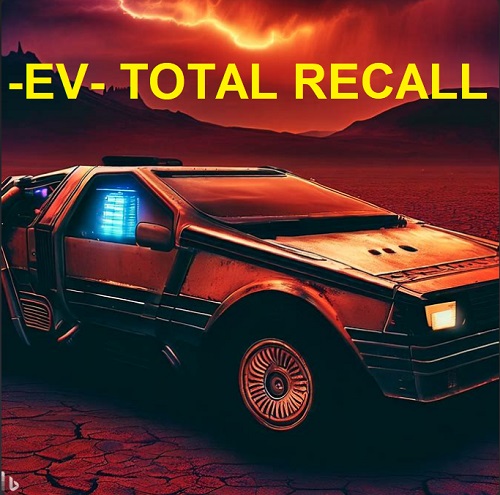
Warranties: Often 8 Years & Many km
If your EV battery is replaced under warranty, that’s annoying but not disastrous. It can even be to your advantage if you end up with a brand-new battery after subjecting your old one to a few years of wear and tear. Most battery pack warranties in the US are for 8 years or 100,000 miles. Whichever comes first. Translated into Australian, that’s 8 metric years or 160,000km. Technically, it should be 160,934km, but it gets rounded down. While that’s not a huge sin, they sometimes “round down” the years. Hyundai offers 10 years or 100,000 miles warranty in the US, but here it’s only 8 years or 160,000km. Hopefully, Hyundai will soon give us 10 years as well. It’s only fair since we’re better looking.
EV Range Loss
The study says the most range loss from battery degradation occurs early in an EV’s life, and the results back this up in all but one case. I’ll give what percentage of range remains when the EVs hit 60,000 miles and, when information’s available, 100,000 miles.
Because there is 1.60934km in a mile and the average annual distance vehicles are driven in Australia is 13,000km, this means:
- 60,000 miles = 96,500km or 7.4 years of average Oz driving.
- 100,000 miles = 161,000 km or 12.4 years of average Oz driving.
Note the EVs in this study have been driven much more than the Australian average each year. This means we should expect greater range loss per km for those driven the Oz average due to the effects of time. The good news is, because the rate of loss flattens off in all EVs studied, the extra range loss — hopefully — will not be great.
All the range percentages I give are average results. There can be considerable variation between individual vehicles.
Nissan Leaf
The Nissan Leaf is the first EV produced on a large scale this century1 and began production in 2010. Over the years, several battery pack capacities have been available.
The largest and newest battery pack is 62 kilowatt-hours (kWh). Because it’s the newest the study only gave information on it up to 125,500km:
- 62kWh Nissan Leaf at 96,500km 95%
- 62kWh Nissan Leaf at 125,500km 95%
The largest battery pack Nissan Leaf held up well and suffered no significant range loss over its final 29,000km.
While the 40kWh Leaf isn’t as new, its results still didn’t reach 161,000km. The study only has information to 153,500km, but that’s 95% of the way, so it’s not far off :
- 40kWh Nissan Leaf at 96,500km 99%
- 40kWh Nissan Leaf at 153,500km 99%
As you can see, the 40kWh Leaf has superb range retention and only lost around 1% of its range after being driven over 150,000km2.
I didn’t expect a great result from the 22kWh Leaf, as the study would have included some of the earliest lithium EV battery packs created. But while it didn’t retain as much range as newer Leafs, it still did well:
- 22kWh Nissan Leaf at 96,500km 93%
- 22kWh Nissan Leaf at 161,000km 91%
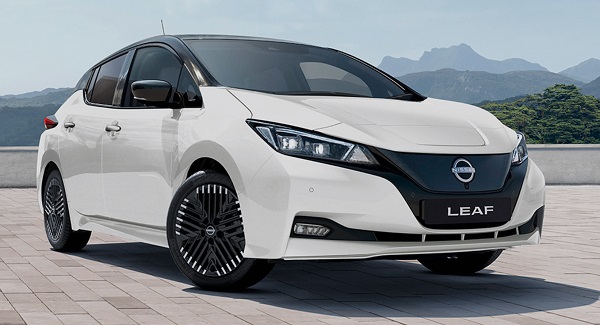
This is a real picture of a real Gen 2 Nissan Leaf. It’s not an AI hallucination. (Image Credit: Nissan)
Tesla Model S
The Tesla Model S has had several battery pack sizes available, and the study looked at the two most common. The largest, and only size available today, is 100kWh. The other is 75kWh. Many of these vehicles were sold with unlimited Tesla supercharging, and so people tended to use that a lot. Because it’s harder on battery packs than a normal home EV charger it may have significantly contributed to range loss, but the study didn’t attempt to quantify this.
The 100kWh battery retained the following amounts of original range:
- 100kWh Tesla Model S at 96,500km: 79% of original range
- 100kWh Tesla Model S at 161,000km: 77% of original range
Losing over 20% of its range before hitting 100,000km surprised me because it’s very different from this graph provided by Tesla:
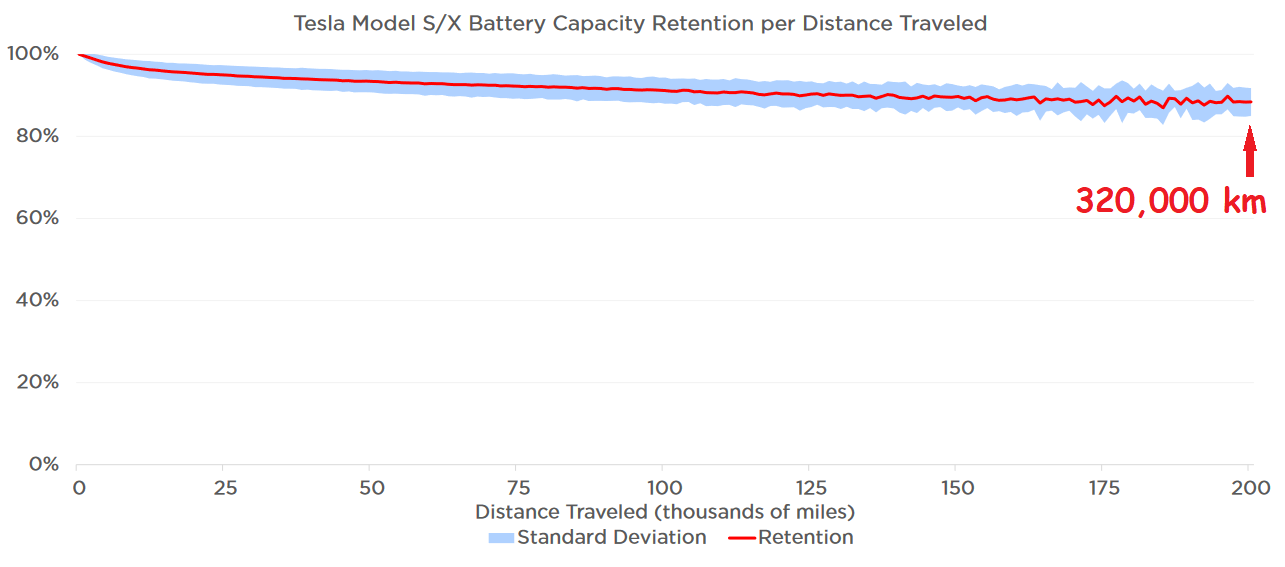
This graph is from page 22 of Tesla’s 2020 Impact Report. They use the same graph in their 2022 Impact Report but made the colours greener. (I added the red arrow and comic sans myself.)
Fortunately, there wasn’t much change over the next 144,000km as the range only dropped down to 77%. So while not nearly as good as Tesla’s graph would suggest, this does suggest the battery will last a long time.
The 75kWh Model S did a lot better:
- 75kWh Model S at 96,500km: 96% of original range
- 75kWh Model S at 161,000km: 92% of original range
Now that’s much more like Tesla’s graph. However, the 75kWh Model S is no longer produced. New ones all have 100kWh battery packs, but it’s not the same as the original 100kWh battery many or most of the vehicles in this study would have had. This makes me hope a 100kWh Model S sold today would suffer range loss similar to or less severe than the 75kWh version.
Tesla Model 3
Tesla Model 3 EVs with 75kWh batteries fared well:
- 75kWh Tesla Model 3 at 96,500km: 93% of original range
- 75kWh Tesla Model 3 at 161,000km: 92% of original range
While they’d lost more range at around 100,000km than the 75kWh Tesla Model S, at 161,000km they were the same.
The 50kWh Model 3 didn’t do as well:
- 50kWh Tesla Model 3 at 96,500km: 84% of original range
- 50kWh Tesla Model 3 at 161,000km: 83% of original range
While its early range loss was considerably worse than its bigger battery brother, there was little loss from 100,000km to 160,000km, which is a good sign.
The version of the 50kWh Model 3 currently sold in Australia is made in Shanghai and has a different battery pack from the American-made ones in this study.3. It uses a different lithium chemistry from the American one, so its range loss may be very different. Because it’s newer, I’ll cross my fingers and hope it suffers less range loss.
BMW i3
Recurrent looked at BMW i3 EVs with 3 battery pack sizes. I’ll give information on the larger 42kWh and 33kWh ones.
Because the 42kWh BMW i3 hasn’t been around that long, the study only gave information up to 88,500km:
- 42kWh BMW i3 at 88,500km: 93% of original range
Because range loss from 50,000km onwards was minimal, it looked likely to still be at 93% at around 100,000km.
Information for the 32kWh BMW i3 didn’t start until it hit 16,000km, so all I can do is indicate how much range was lost from that point on:
- 32kWh BMW i3 at 96,500km: 93% of range at around 16,000km
- 32kWh BMW i3 161,000km: 83% of range at around 16,000km
While the actual range loss is unlikely to be significantly worse than this, it’s impossible to be certain from the study results.
Hyundai Ioniq 5
Information on the Hyundai Ioniq 5 was only available up to 134,500km:
- 77kWh Hyundai Ioniq 5 at 96,500km: 93% of original range
- 77kWh Hyundai Ioniq 5 at 134,500km: 93% of original range
From 50,000km onwards range held extremely steady with no noticeable loss. I hope the battery can maintain this out to 161,000km and beyond.
Ford Mustang Mach-E
The Ford Mustang Mach-E isn’t currently available in Australia but should soon arrive in small numbers. Right-hand drive versions are already on sale in the UK and New Zealand. Clearly, Ford is testing them out in lesser countries to see if their product is worthy of us4. The Premium Rear Wheel Drive Extended Range version has been around in the US long enough for the study to have measured range loss out to 93,500km:
- Ford Mustang Mach-E Premium RWD Extended Range at 93,500km: 99%
After a mild decline, the vehicle’s range began to slowly improve after 45,000km. But there’s nothing strange going on. It’s not a magic pudding battery.
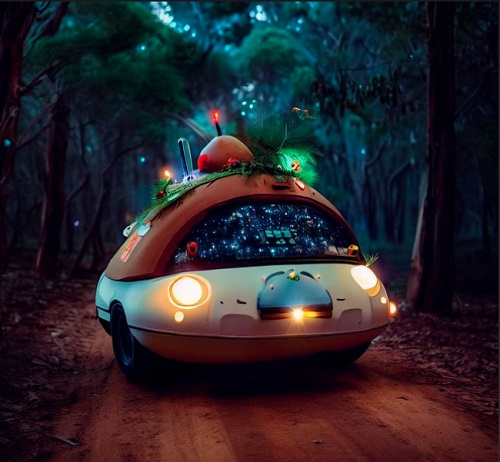
Apparently, this is an Australian magic pudding electric car. If you don’t like it, take it up with Skynet.
As a manufacturer becomes more confident about a new EV and its battery pack, they can send updates that can improve the car’s performance or allow more battery capacity. Over time, the improvements tend to become minor, so don’t expect any miracles from this.
Winners & Not Exactly Losers — 96,500km
Ranking the vehicles’ remaining range from best to worst at 96,500km gives:
- 40kWh Nissan Leaf 99%
- Ford Mustang Mach-E Premium RWD Extended Range 99%?
- 75kWh Tesla Model S 96%
- 62kWh Nissan Leaf 95%
- 22kWh Nissan Leaf 93%, 42kWh BMW i3 93%, 77kWh Hyundai Ioniq 5 93%, 75kWh Tesla Model 3 93%
- 32kWh BMW i3 93%?
- 50kWh Tesla Model 3 84%
- 100kWh Tesla Model S 79%
There’s a question mark next to the Ford Mustang Mach-E because its info only went up to 93,500km. There’s also one next to the 32kWh BMW i3 because we can’t be certain about its range loss. But I think putting the Ford in 2nd and the 32kWh BMW in 6th place is reasonable.
The 40kWh Nissan Leaf took the top spot, and in clear last place was the 100kWh Tesla Model S that only retained 79% of its original range after being driven fewer km than the average Australian car racks up in 8 years. This is in surprising contrast to the 75kWh Tesla Model S, which still retained 96% of its range. So Tesla can clearly make EVs that lose little range. It just doesn’t always happen — at least not in the past.
There were no major losers because, while a couple of Tesla models weren’t great, none of the range loss was excessive. They did well enough to put fossil fool claims about EV range to shame.
Winners & Not Really Losers — 161,000km
When all the EVs that did the distance — or close to it — are ranked from best to worst for range retention at 161,000km, it gives:
- 40kWh Nissan Leaf 99%?
- 75kWh Tesla Model S 92%, 75kWh Tesal Model 3 92%
- 22kWh Nissan Leaf 91%
- 50kWh Model 3 83%
- 32kWh BMW i3 83%?
- 100kWh Tesla Model S 77%
The 40kWh Nissan Leaf has a question mark next to it because its information only went up to 153,500km, but since it retained 99% of its original range while covering 95% of the distance, I think it’s fair to give it 1st place. The 75kWh Tesla Model S did well, taking 2nd place, but the 100kWh version came last with 77% range retention over km, equal to around 12 years of average Australian driving.
The 32kWh BMW i3 has a question mark next to it because it’s impossible to be certain about its range loss. But because I’m confident it did better than the 100kWh Tesla Model S, 5th place seems reasonable.
Minor Range Loss After 50,000km
While there’s considerable variation between EVs, generally speaking, most of the decline in range occurs before 90,000km. For vehicles that went the full distance — as well as the 40kWh Nissan Leaf which nearly did — the range loss between 96,500km and 161,000km — as a percentage and as percentage points5 — was:
- 40kWh Nissan Leaf 0%
- 75kWh Tesla Model 3 1%, 50kWh Tesla Model 3 1% (1 percentage point)
- 22kWh Nissan Leaf 2%, 100kWh Tesla Model S 2% (2 percentage points)
- 75kWh Tesla Model S 4% (4 percentage points)
- 32kWh BMW i3 11% range loss (10 percentage points)
The 40kWh Nissan Leaf only lost a few km of range, which is next to nothing and — after rounding — it is! The only EV without good range retention was the 32kWh BMW i3. The majority had their range drop by ~2% or less over 64,000km or around 5 years of average Australian driving. While there may be some range loss early on, this suggests range loss later in life will be very slow for most EVs.
While it would be nice if this gradual decline continued for decades or millions of km, at some point range loss will either increase or the battery will fail in a more sudden way. Hopefully, this will take a long time to occur in most cases.
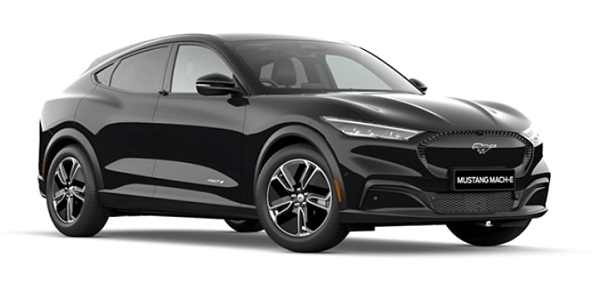
This is what the Ford Mustang Electri looks like. (Image Credit: Ford)
EV Battery Replacement Cost In The US
If an EV battery needs to be replaced while it’s not under warranty, it can be bloody expensive. Recurrent gives US replacement costs on this page. I’ve put the prices they give for 5 EVs below. I’ve converted them directly into Australian dollars at the current exchange rate of 66 US cents to the Dollarydoo. I haven’t tried to adjust them to account for GST or US taxes:
- Nissan Leaf: $8,300-$14,400
- Tesla Model S: $18,200-$33,300
- Tesla Model 3: $24,000
- BMW i3: $3,800-$24,200
- Volkswagen e-Golf: $35,500
As you can see, replacing a battery pack can be extremely expensive even in a country with a more mature EV market like the United States.
At the moment manufacturers pay around $200 per kWh for EV battery packs. That’s $10,000 for a 50kWh pack. When battery packs get down to $100 per kWh, which they eventually will — in today’s money at least — it will only be $5,000. But in the same way it’s nearly impossible to buy a car part at the same price vehicle manufacturers pay, it may be very difficult to get a replacement battery at close to cost.

This isn’t what the Ford Mustang Electric looks like. (Image Credit DALL-E image generator)
How To Improve Things
At the moment, there are a considerable number of subsidies and incentives for EVs in Australia and around the world. If we want to incentivise longer-lasting batteries, governments should consider directing more subsidies towards EVs that have…
- Longer battery pack warranties: I think 10 years should be a minimum for an EV battery pack warranty rather than the 8 years that’s currently typical.
- Longer vehicle warranties: Apart from the battery, there’s not a lot that can wrong with an EV, so it should not be difficult or expensive to provide long warranties for them.
- Minimal or no maintenance requirements: Car companies will be tempted to charge people for maintenance that is not required. This should not be encouraged, as it wastes resources and reduces the value of second-hand vehicles.
- No restrictions on third-party battery replacements: If manufacturers can control which batteries can be used as replacements, or who can replace them, they will jack up prices.
Is Recurrent Gilding The Lily?
The results of the Recurrent study show EVs are generally very good at retaining range even after racking up enough km to travel 44 times the distance between Sydney and Perth. But it is fair enough to wonder — are they incentivised to exaggerate battery longevity? Their goal is to help sell second-hand EVs, so they have a vested interest in portraying EVs as lasting a long time.
Fortunately for my faith in American trustworthiness, which isn’t that high — in part due to someone whose name rhymes with “Elon Musk”6 — their results are similar to what I’ve heard from EV owners online and other sources. So I’m confident they aren’t putting their thumb on the scales.
EV Batteries Can — Usually — Go the Distance
The Recurrent study shows EV batteries can last a long time. While most suffer a modest decrease in capacity early in their life, for all but one EV in the study, it dramatically reduces over time. One vehicle, the 40kWh Nisssan Leaf, suffered only around 1% range loss after travelling over 150,000km, which shows it’s possible to make battery packs that suffer minimal deterioration.
While battery reliability is improving, because the technology is changing rapidly, some people will inevitably get bum batteries that have to be replaced — either as part of mass recalls or in individual vehicles. But as batteries improve in quality, this will happen less often.
Provided a battery replacement occurs under warranty, it’s not a major issue. But if you do have to pay out-of-pocket, it is a serious problem because it’s bloody expensive at the moment, and it may remain so in the future. You can partially protect yourself by ensuring your EV has a good warranty. For most Australians, the number of years a battery warranty has is more important than the number of km covered.
The results of this study, as well as information from other sources, has improved my EV optimism, and I’ll say that I’m confident the majority of EVs sold in Australia today, for household use, will still have their original batteries in 20 years’ time. Unless, of course, they’re all replaced by robo-taxis. Or our robo-masters force us to travel by catapult or something.
Footnotes
- In 1899 the Electric Vehicle Company was the largest motor car manufacturer in the United States.
- I must remember to buy a second-hand one before everyone reads this and the price goes up.
- The Shanghai one has a 57.5kWh battery pack with lithium ferro phosphate (LFP) batteries. The US one was 54kWh in total and NCM, nickel cobalt manganese.
- Lesser, as in less land area. What did you think I meant? Australia is a big country, we need reliable vehicles!
- The 32kWh BMW i3 lost 11% of its range from 96.500km to 161,000km which caused its range loss to decline by 10 percentage points from 93% to 83%.
- Yes, “Elon Musk” rhymes with “Elon Musk”.
Original Source: https://www.solarquotes.com.au/blog/ev-batteries-lifetime/

